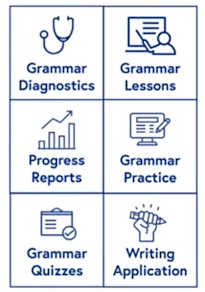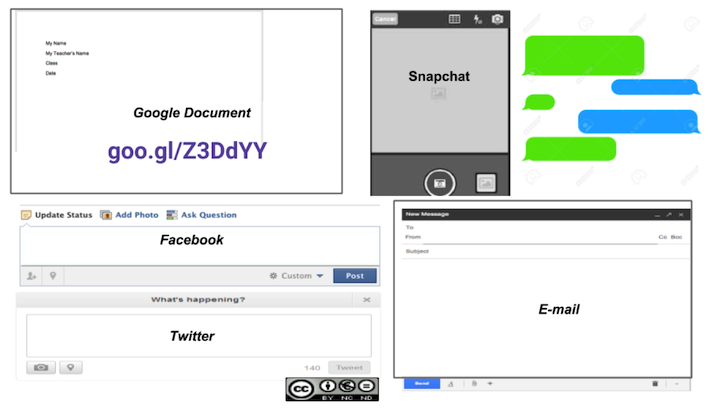Use This Strategy to Groom Grammar Gurus
 Grammar instruction has been an enigma to many English language arts educators. Let’s be honest. Some teachers even cringe at the thought of teaching it.
Grammar instruction has been an enigma to many English language arts educators. Let’s be honest. Some teachers even cringe at the thought of teaching it.
Whether you teach your students grammar in isolation or as a regular part of your writing assignments, capturing their interest consistently is challenging. And there’s nothing new about that. As far back as the late 1800s, educators observed that students might memorize grammar rules long enough for a test, but still not apply the rules in everyday writing.
As a middle school teacher, I have tried many instructional strategies to get my students more engaged with grammar. I’ve asked other teachers how THEY do it. I’ve read helpful books by Constance Weaver, Jeff Anderson, and other leading experts on teaching grammar. After all this asking, reading and experimenting, here’s what my current favorite practice looks like.
Student Writing Spaces
Middle school students today are much different than we were 15 or more years ago. Cell phones, tablets, and other technology have become pervasive since the mid-2000s and are a huge part of who students are today. Digital life defines them, and it isn’t going away.
I have always been fascinated with the implementation of technology and how students can use their devices without being distracted in the classroom. So the question for me became: How can we approach grammar instruction using the digital spaces where students tend to spend so much of their time?
When it comes to grammar, the first concept I always address with my students is the difference between formal and informal writing. I also want to communicate my respect for the spaces they write in every day.
To help with this, I created a grammar template that my students can use to differentiate among the spaces they routinely use for writing and communication. With this understanding at their fingertips, they can gain the necessary grammar skills for the formal writing needed to be successful in high school and beyond.
This interactive template is free to use and was put together using Google Slides. I created it for a book I co-authored with Dr. Troy Hicks several years ago, From Texting to Teaching: Grammar Instruction in a Digital Age. You can update it with current favorite writing spaces.
For me – for anything we teach – application is huge. If students are unlikely to ever apply a skill we might expect them to learn, there is no need to teach them the skill. They have to see purpose in what it is they are doing, or they will not develop a vested interest.
This template helps them understand our purpose. Read on to learn more about how I use it with my students.
Mentor Texts & Sentence Hacking
Most teachers already know about using mentor texts to help students see the moves authors and writers make. This should include grammar moves as well.
I always like to start the year with the novel The Outsiders by S.E. Hinton with my 8th graders. Besides being a classic, the story always captures their attention right away and has proven to be a perfect mentor text for students to learn types of sentences.
Hinton’s text provides numerous examples throughout and shows students that their writing can become more rich using a variety of formal and informal sentences and grammar. I always present a mentor sentence to the students in the Google Document part of the template, then break it down further for the students in an activity I call sentence hacking.

Source: GrammarFlip
Day 1: Students are introduced to the grammar template with its different social media spaces and discuss the differences between formal and informal writing. Students then access the template and make a copy on day one to familiarize themselves with it – navigating text boxes and also discussing the template with a partner. (The template can be adapted to younger grades by reducing the number of writing spaces). Students can also give feedback on what spaces they use the most. I have students use GrammarFlip as a resource to give them extra help.
Day 2: Students are given a mentor sentence with the particular grammar focus for the week. For example, Cherry was stricken when she heard that Bob had died.
This particular sentence example looks at complex sentences. The first thing to do with the students is to identify the parts of the sentence that make it a complex sentence.
Then the students use the grammar skill and decide what the mentor sentence could possibly look/read like in the different writing spaces identified on the template. (I always allow the students to put the mentor sentence in the Google Doc section “as is” and ask them to find images for social apps like Instagram).
Day 3: Day three is typically a solid workday for students. Day two usually brings a lot of questions from them. This is also a great time to discuss with students fair use policy and how to give credit when they find images they use from the internet to complete the Snapchat or the Instagram space. Students are formatively assessed when they share their template with me.
Any issues that may arise will be addressed in a whole-class discussion before proceeding with our formal writing assignment where they will demonstrate their skills. Students can access the feedback through the comment feature within Google Slides. In addition, they will create a “Grammar Goodies” online folder for the templates and other grammar resources, which they can access at any point.
Code Switching
We do code switching every day and so do our students. Simply put, code switching is choosing to use a particular dialect or language based on cultural or social situations to help a person have an identity. Students typically don’t talk to their families or teachers the same way they talk to their friends.
Code switching has been a topic of conversation that goes back as far as the 1960’s when schools were desegregating and different language dialects were being spoken within the classroom. Kristen Hawley Turner wrote a much-read article in English Journal in 2009 promoting the idea of students using their own language and teaching them to code switch in class.
With all the texting going on today, Turner’s note is more relevant that ever: “Using text speak as an example of code-switching may acknowledge the legitimacy of the language while bringing its use to the conscious level, where students can choose to use it or not, depending on the context” (Turner, 61). Turner’s comment is true for me with the template my students complete.
According to the article “Codeswitching: Tools of Language and Culture Transform the Dialectally Diverse Classroom” by Rebecca S. Wheeler and Rachel Swords, there is the common misconception that only one “standard“ (474) exists for teaching English to students, when in fact there are formal and informal standards that do exist and can be easily taught to students. Furthermore, students can truly identify the differences between formal and informal English standards when given the opportunity to practice code switching.
Bottom line, I want my students to be able to know when to use their texting talk and when not to use it, when it comes to their own writing (informal vs. formal). I don’t want to reject what we once called “slang” or “inappropriate” tween/teen language out of hand.
Final Thoughts
I know that I don’t have the magic grammar lesson to reach every student and have it stick. I also know that handing them worksheets to learn grammar skills is never the right answer. In addition, teaching grammar in isolation never works either.
A few key philosophies that I have for teaching grammar are:
- Meet students where they are and respect the spaces they write in daily.
- Show students the “why” of using certain grammar skills, and they will apply it to their own writing.
- Invite students to try new things, and don’t be quick to get that red pen out.
By developing these philosophies, I have been able to reach more students and get them to have a deeper understanding of why it is important to learn the grammar skills and how those skills might actually power up their ability to communicate.





































